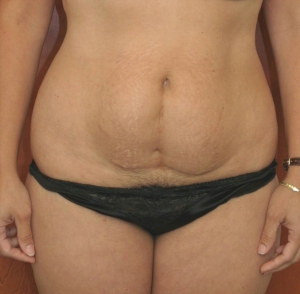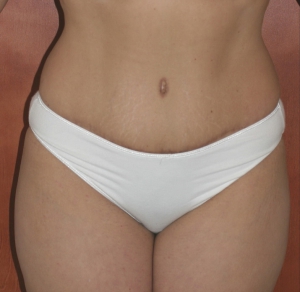Tummy Tuck (Abdominoplasty)
For most people, even those who exercise regularly and limit the intake of fats and sugars, the abdomen is a difficult area to keep toned and flat. After pregnancies, and the weight fluctuations linked to each baby, this challenge can intensify. A tummy tuck, or abdominoplasty, addresses this by tightening abdominal muscles, realigning them to the center of the stomach, and eliminating excess skin and fatty tissue.
Good Candidates for a Tummy Tuck
A tummy tuck may be right for you if you have:
- Weak stomach muscles with central separation due to pregnancy
- Sagging or excess skin in the abdominal area
- Fat in the lower abdomen that is unresponsive to exercise
- Significant weight loss or previous bariatric surgery with subsequent significant weight loss
Women typically undergo the tummy tuck operation after completing pregnancies and stabilizing their body weight. Having a tummy tuck will not prevent future pregnancies. However, having a pregnancy after a tummy tuck may require a surgical revision of the previous tightening. During your consultation with Dr. Behmand, he will assess your overall health, skin tone, fatty tissue distribution in the stomach area, and if applicable, check the scars from previous abdominal surgeries.
FAQ’s
-
Does insurance cover an abdominoplasty for any reason?
- Abdominoplasty is an elective procedure. Insurance does not cover abdominoplasty.
-
Can an abdominoplasty be combined with other procedures?
- Yes. The procedures most commonly combined with an abdominoplasty are liposuction, and breast surgery. When you come in for your initial consultation, please inform Dr. Behmand of any other considerations or surgical procedures you would like to discuss.
-
What is the difference between a mini abdominoplasty and a standard abdominoplasty?
- Dr. Behmand performs a standard abdominoplasty to surgically remove excess skin, and fatty tissue from the mid, and lower abdomen. During the procedure, he tightens the stomach muscles, and repositions them centrally. A standard abdominoplasty is the stomach tightening procedure of choice for the majority of patients. The operation corrects both the separation of abdominal muscles, and removes excess from above, and below, the belly button.
The mini abdominoplasty is a surgical procedure to remove excess skin and fatty tissue from the lower abdomen only. It does not address any skin laxity above the belly button, nor does it correct separation of the stomach muscles. Mini abdominoplasty has an easier recovery, and no scar around the navel. A mini abdominoplasty might be a suitable option if you only have a moderate amount of loose skin, and fatty tissue below the navel.
-
Can this be done under local anesthesia?
- No. Abdominoplasty is performed under general anesthesia, in a surgical center.
-
Do you use drains for an abdominoplasty?
- No. Dr. Behmand has a technique that typically allows you to have a more comfortable “drain-less” recovery. Dr. Behmand will discuss this with you in more detail during your consultation.
-
Can I have an abdominoplasty if I plan to have children in the future?
- You can undergo an abdominoplasty even if you plan to have children in the future. This won’t impact your ability to get pregnant. However, a revision surgery may be necessary after completing your family.
-
Where is the tummy tuck scar?
- The tummy tuck scar follows the pattern of a bikini bottom, extending from hip bone to hip bone. The incision is strategically placed as low as possible to optimize aesthetics. Additionally, Dr. Behmand employs sutures to permanently secure the scar in place, minimizing the risk of upward migration during healing. This approach ensures optimal aesthetics and allows for versatility in the types of underwear and bathing suits that can be worn post-surgery.
-
How long does the swelling after a tummy tuck last?
- Being swollen after a tummy tuck is a common occurrence. Initially, in the first 4-6 weeks post-surgery, patients typically experience the highest level of swelling following a tummy tuck. Subsequently, there’s a gradual and substantial reduction in swelling. However, over the first 6-12 months post-surgery, some degree of swelling may persist. During this recovery period, you’ll observe ongoing improvement as your results become increasingly defined.
The Tummy Tuck Procedure
Dr. Behmand uses an innovative technique of progressive tension sutures to perform the abdominoplasty without drains. A drain-less tummy tuck has several advantages. These include: 1) the ability to shower within a few days after surgery, 2) increased post-surgery comfort, 3) elimination of the scars associated with drains, 4) and stabilization of the tummy tuck incision in the desired low location. The drainless abdominoplasty is the height of innovation in plastic surgery for improved postoperative comfort and superior aesthetic results.
Recovery After a Tummy Tuck
To enhance circulation and minimize post-surgical risks, get out of bed and walk around in the days following surgery. Pain medication will be prescribed to alleviate discomfort, and some patients choose extended release local anesthetic for added pain control. It’s advised to avoid strenuous exercise until at least 6 weeks after surgery, as tissues and abdominal muscles need this time to reach necessary strength.
“My very own miracle working surgeon. I thank god every day for your talent and skill…giving me the body I have always dreamed of. I walk in my life with confidence and strength. What I carry inside is now reflecting on the outside. Thank you.”
Tummy Tuck Cost
The price of a tummy tuck typically falls between $12,000 and $16,000, though it can vary depending on individual factors such as the patient’s size, existing physical conditions, and the duration of the operation. Additional procedures performed simultaneously would also increase the total cost.











